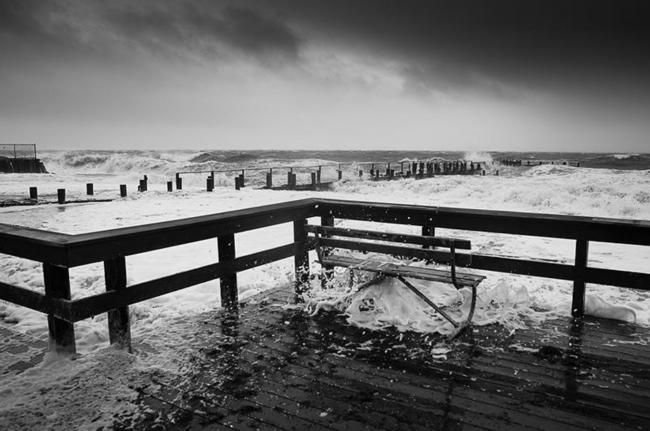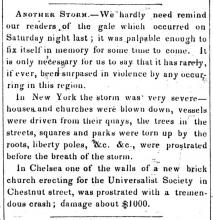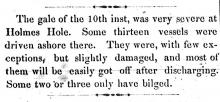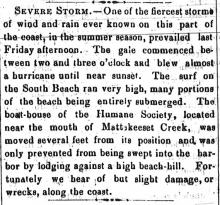The shock waves of last week’s storm are still rippling through Island fields as farmers anxiously watch their crops to see the extent of the damage.
Scorched leaves and windblown plants are the legacy of Hurricane Bob across the Island. Farmers are now harvesting the remainders of some crops and continuing to market their goods. Many say the storm came at the peak of an excellent season, eradicating some crops that would otherwise have continued through the fall.
Some plants made it through the storm’s worst gales. Tomatoes on the ground seemed especially hardy, though ones on trellises were mostly a loss. Most of the sweet corn at Hillside Farm and Morning Glory Farm survived, though the late varieties still pose a question mark. Much of the Island’s flowers, peppers, and lettuce proved a pushover for Bob’s force. Pumpkins and the winter squash crop may be scarce on the Vineyard this fall.
Changed on the Island’s agricultural landscape have already extended to the farmers’ market, where organizers spoke this week of cutting the market season a month short. At Saturday’s market only 21 of the 45 vendors came to sell their goods.
Other places felt the storm’s pinch. Thimble Farm was slated to open its raspberry fields for picking when the hurricane hit, but the storm put an abrupt end to the late summer raspberry season. The strawberry crop may still be available.
Apples were another casualty of the storm. The apple trees at the Magnuson orchards have lost 80 per cent of their yield, Eric Magnuson said this week. Out of 100 trees, 14 blew over in the storm and are now righted with wooden supports.
Feed corn at Katama Farm may have suffered the brunt of the storm’s fury as 100 acres were pounded. Jim McCarthy of the farm said the corn survived the wind, but the combination of salt and sand may take its toll. The loss could result in costs of $70,000 to $80,000 to replace the crop.
“The irony is that it was the best corn we ever had and along comes Hurricane Bob,” Mr. McCarthy said Saturday. “We went from an all-time high to an all-time low.”
Mr. McCarthy said he will know by week’s end if the corn will survive. The corn, which feeds his herd of 135, yields 17 to 20 tons per acre, translating to 18,000 tons. The crop was planted to mature later in the summer.
Mr. McCarthy said the cows were his first concern. He reports that the herd was saved and not one drop of milk was lost. A generator pumped out enough power for three days to milk the cows and keep the ice cream and milk cold.
Many farmers said they were on the track to come out ahead this year, but the storm has seriously dented their expectations. Now farmers are beginning to look toward possible disaster relief. Aid may come from federal funds or from other loans.
Paul Russell, district director of the Agricultural Stabilization and Conservation Service (ASCS), will visit the Island Wednesday to assess damage. The ASCS is a branch of the United States Department of Agriculture.
William Wilcox of the Dukes-Nantucket Cooperative Extension Service has coordinated the visit as part of the cooperative extension’s role to help farmers estimate levels of assistance necessary and to help with technical matters. He said each farmer may have to file a report for assistance.
“I think Mr. Russell’s report will play a major role in whether the USDA provides funding,” Mr. Wilcox said yesterday.
The aid is further emphasized by the critical juncture in the farming season. Mr. Wilcox said the economic ramifications are startling for many farmers in the wake of the hurricane.
“The last two weeks in August and the month of September is the time when farmers go from the red into the black,” he said. “All season long goes to paying expenses. This is a really serious time to have crops ruined by any problem.”
The dry nature of the hurricane compounded the storm’s effects, he said. The damage to the leaves occurred through osmosis, the movement of water from a low concentration of salt to a higher concentration, which was then compounded by the wind stripping moisture from the leaves.
“When you get a dry hurricane the process happens overnight,” Mr. Wilcox said. He said although the rain subsequently fell, it was too little, too ate to reverse the damage.
Saturday at the farmers’ market, vendors who gathered discussed the state of their plants, agreeing that the salt spray had turned the leaves brown and parched.
“To me it looked like the angel of death flew over,” said Beth Summers of Quansoo Farm. “The salt spray from the ocean turned everything black. The garden was at its height so it was quite a contrast to see the storm’s result.”
Her area at the market, which ordinarily overflows with flowers and produce, was pared down to baskets of cucumbers, zucchinis and tomatoes which survived the blow. She pointed out the skin of one cucumber where the wind pushed it across the ground. It was discolored and scratched.
Nearby, market organizers BZ Hull and Robin Brown decided to set a tentative date of Sept. 21 for the season’s last market. BZ, owner of Charlotte’s Garden, said most of her flowers were blown away by the storm, though her greenhouse narrowly avoided destruction.
“I know a lot of people are hurting,” BZ said. “When you have enough people drop out, everyone suffers because there’s not enough variety.”
Despite missing vendors, there was still a substantial amount of produce and goods available, and a good crowd attended the market.
Many at the market agreed that this summer’s season was ahead of schedule, reaping early crops and narrowly avoiding a debilitating drought. Glenn Hearn, owner of Tiasquam Brook Farm, was selling plants he had rescued from the storm.
“It’s too bad because it really was such a good summer,” he said. “Maybe nature planned it that way to give us a head start.”
Andrew Woodruff, owner of Whippoorwill Farm, was one of a few Islanders left with flowers after Bob struck. He expects his tomato crop to be half the quantity anticipated for September. He gathered 2,000 pounds of tomatoes before the storm struck. He expects his tomato crop to be half the quantity anticipated for September. He gathered 2,000 pounds of tomatoes before the storm struck and although he picked 1,200 heads of lettuce Monday morning, he lost most of it when the cooler lost power.
Donny Mills of Hillside Farm said he has about three weeks’ work to repair his greenhouse, where the panes were blown out. He has now organized his schedule on a week-to-week basis to see what crops will survive. Saturday he went out to pick corn, which was in plentiful supply, though his beans were wiped out and he said he doubted the green pumpkins would ripen.
“I just want to get over this and make next year closer,” he said. “Last weekend seems a month ago. It’s been the longest week I can remember.”
There was good news at Nip ‘N’ Tuck Farm. Fred Fisher Jr. said one bull calf was born during the storm, as were five piglets. On Tuesday Mr. Fisher took five cows to Katama Farm to have their milk processed, though he worked his generator to milk his other cows at the farm. He compared the tree destruction to the 1938 hurricane.
At Morning Glory Farm, Jim Athearn was picking ripe corn Sunday. The farm stand will be open through Thanksgiving, he said.
He reported his best pepper crop was destroyed by the storm. He said his adult corn was knocked down by the wind, but straightened up within three days. The farm lost the cultivated flowers which produced 70 to 80 bunches per day.
“We’re very concerned because it doesn’t take more than a 10 per cent drop to put us on the down side of the ledger. We don’t know if we will be able to make this year work for us,” he said.
“Every year there have been times when it looks terrible, but in the end things turn out all right and we go on.”











Comments